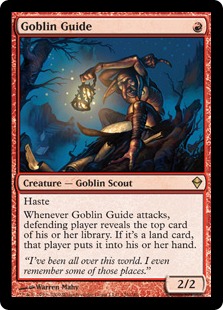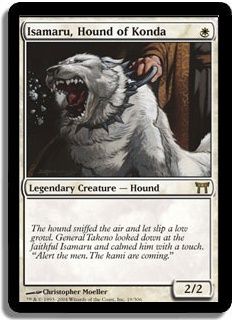When you build a cube, you’re sculpting a Draft format using a few hundred of the 10,000+ cards printed. The hard part – once you get beyond the tough cuts and the past format all-stars that just don’t work out – is that the underlying card pool isn’t perfect. You strive for color balance in your cube – but fundamentally, the five colors aren’t balanced. You want to run the best gold cards – but one guild or shard may have many more powerful options than another. Building a cube ends up being about the alchemy of choosing a balanced subset from a more chaotic whole.
Choosing the Right Depth
The most overarching problem to deal with is the history-of-the-game-long imbalance between oh, say, blue, and other colors. Because blue has spent so much time being the best, there’s no guarantee that the 60th best red card is of an equal power level to the 60th best blue card. As we all know intuitively, some colors are deeper than others. There’s also probably a difference in the quality of the best card of each color, but that’s less of a problem because one card won’t determine how your cube plays – each section as a whole will.
Luckily, it’s not impossible to deal with the issue of depth – you just have to be conservative about the size of the cube. If you could happily run 80 white cards but you’d be stretching to find that many in green, then 80 is too large a section for your cube.
Personally, I feel that red is the limiting factor in terms of size – there are very few cards that I’m really sad to cut, whereas blue, white, and black have a number of options I’d love to have room for. It doesn’t matter which color is the limiting factor, though – just that you identify which it is and adjust the size of your cube accordingly.
Managing Effective Rarity

The average power level isn’t the only way in which the size of your cube affects balance. In the cube, you’re creating your own rarity using redundant effects. For example, if you want the Terror effect to be common in your cube, you’ll run not just Terror but also Doom Blade, Snuff Out, Slaughter Pact, and as many others as you like. But if you run out of copies of a given thing – for example, red aggressive, one-drop creatures – you’re forced to make that effect rarer and rarer the larger your cube is. So if you want that effect (your generalized Goblin Guide) to be effectively common or uncommon, you’ll need to keep your cube small.
Balancing Power Levels Through Focus
Another factor that can lead to imbalance is that some colors just have access to more effects than others. For example, people who haven’t cubed before sometimes guess that white is weak, probably because white tends to get some underwhelming effects like life gain and damage prevention at low rarity. But less frequently and at higher rarities, white has the best early creatures, the best finishers, the best spot removal, the best mass removal, answers to every permanent type, and mass land destruction. Gulp. The result is that white in the cube is super strong. A wide variety of white decks are able to present threats and answer those of their opponent. One thing I really like about white in the cube is that it doesn’t feel like you have to include a bunch of the same effects – there’s a wide variety of strong cards available.
In other colors, you don’t have the luxury of variety. If you tried to run sixty unique effects in red, you’d end up with a much weaker red section than if you were willing to run many redundant burn spells.
In general if a color seems to have all of its good cards focused on a certain effect, it’s a mistake to try to push that color towards something else. Instead, colors like red and green that do a few things really well will be stronger if you make them more focused. By emphasizing effects that have a lot of redundancy (like acceleration in green and burn and LD in red), you create more consistency within that color. It’s not necessarily the most interesting thing, but it helps intrinsically less powerful colors compete in the cube.
On the other hand, colors that are already strong can support niche or build-around cards. For example, I don’t mind running Opposition in blue even though there are some blue decks that just won’t run it. It’s so game-breaking when it works that I think it’s worth the spot despite not being the most maindecked card.
Balancing Multicolor
I like multicolor a lot, and there are plenty of cards like Pernicious Deed and Vindicate that are often worth splashing. The problem with multicolor is that there hasn’t been set after set to explore what each combination can do and provide a deep pool of cards to choose from. This problem is even worse in hybrid, which has shown up in only two blocks.
I definitely don’t think that hybrid and gold need to be lumped together for mechanical reasons, but I recently made the change to doing so in my own cube in order to promote balance. Some combinations (W/G comes to mind) have a bunch of options in hybrid. Others, like B/G, have virtually nothing. Using a fixed number of hybrid cards per pair wasn’t working out, no matter what that number was. Even with a small number, we were cutting good cards in some combinations while still running some we weren’t excited about in others.
We decided to go with the imperfect solution of combining gold and hybrid, and now I feel much better about the quality of those cards. We also got more flexible with the Shard spots, swapping in Wild Nacatl for Uril, the Miststalker, which feels pretty good.
In ten years or so, I hope that enough good hybrid cards will have been printed that it makes sense to run a separate category. I love what hybrid does to enable monocolor in less-than-eight-man drafts, and some hybrid cards are super powerful in a two-color deck that can cast them easily. But for now, being flexible about rules and categories leads to a better format at the expense of pretty much nothing.
The rules you have for your cube are undoubtedly different from mine, but the lesson of being open to changing those rules to improve your cube as a whole is a general one. For example, maybe your sections are locked into multiples of five in size, or your artifact section is the same size as WUBRG, or you don’t use Portal cards. Any of those decisions might be fine – but it’s also worth looking to see if those rules are actually helping to create the cube you want to play.
Don’t Miss the Best Cards
One of the easiest ways to miss inclusions for your cube is by comparing them to the wrong cards – specifically to cards they aren’t competing with for spots. It’s never going to be constructive to compare cards of different colors and can lead you into dangerous territory: “If Goblin Patrol is the only other two-power one-drop I can run…
then I just won’t run any of them, Wizards!”
But somehow letting a petulant child manage your cube isn’t too helpful.
Instead, this is exactly the area where you just have to run the best cards you can and avoid looking on the other side of the fence where creatures don’t have drawbacks and card draw happens at instant speed.

For some reason, I find this more difficult mentally when it comes to creatures rather than spells. I didn’t find it difficult to include Harmonize in green (even though Concentrate is never making the cut), but Jackal Pup et al felt too weak compared to Isamaru, Hound of Konda. The catch is that they never need to be compared to Isamaru, since they aren’t competing for inclusion.
There’s a lot of value to looking at your cube as a whole, but this is one time where you can make the best decisions by looking at each section as if it is independent from the others.
The Future
I’ve talked about the ways to inoculate your cube against problems that can seep in from the more chaotic world of Magic as a whole, but I also want to talk about how you can plan to improve your cube in the future.
There are a few easy answers. It’s certain that with each set that comes out, it will be possible to have larger cubes without compromising quality. At the same time, those with smaller cubes will have to make harder and harder cuts – not necessarily a bad thing, but I don’t envy it.
But we can also look at trends in design and development to imagine the future cards that will help to balance the cube. Take red as an example –
I’m not alone in feeling that red is weak in the cube. In
this article
where I played red with my Sealed pool (based largely on my total adoration of Sulfuric Vortex, I admit), several people commented that they never consider playing red in the cube. I get that – red can feel one-dimensional and underpowered, and there’s a fair bit of hate in white.
So what cards could get printed in the future that would make red in the cube stronger? Well, I think cheap/on-a-stick LD would help red as a section, but that’s more or less out of the question. The trend is definitely towards printing only more expensive variants or limiting it to targeting a non-basic (though those cards can still have a home, like Goblin Ruinblaster and Fulminator Mage).
But! Creatures are getting better and better, and to go back to an earlier topic, the best aggressive red one-drop is also the most recent one. So I think it’s more likely that improvements to red in the cube will arrive in the form of more Goblin Guides, Ember Haulers, and Hellspark Elementals.
What you want for each section in your cube might be different from what I want, but I like this exercise to help solidify my thoughts on each section – it’s always good to know what you’re looking for.
